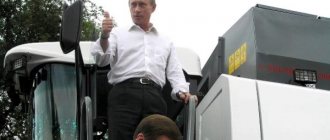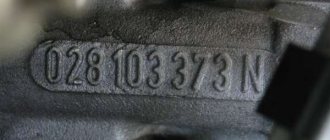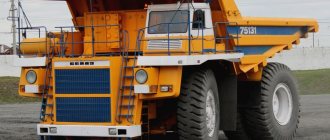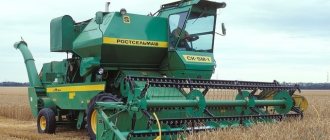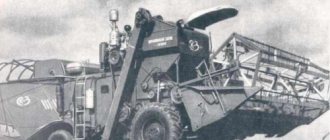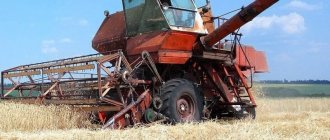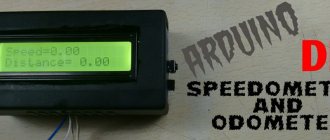Purpose
The main purpose of the combine is to harvest grain crops. The modified modification of Niva SK5m1 is capable of harvesting corn, legumes, and soybeans when installing auxiliary equipment. Currently, the combine is used in small farms that cultivate small areas. This technique is quite suitable for small plots where the use of serious machines with high productivity is not advisable.
Combine harvester Niva SK 5
Specifications
The technical characteristics of the Niva SK 5 combine allow the model to compete with similar foreign devices. General technical indicators:
- Output – 5 kg/sec;
- Hopper capacity – 3000 l;
- Hopper unloading speed – 40 l/sec;
- Unloading height – 2.9 m;
- The transverse size of the header is 5 m;
- Number of knife attachments – 64 pcs;
- Size – 7.6x3.9x4.1 m;
- Weight – 7.4 t;
- Cleaning device – two-sieve;
- The length of the straw walker parts is 3.6 m;
- Number of straw walker parts – 4 pcs;
- Type of threshing and separating mechanism - drum;
- Drum rotation speed – 2900 rpm;
- The cutting speed of the knife mechanism is 750-1235 cuts/min.
Niva 5 is considered a compact device, suitable for large and small cleaning areas with complex boundaries.
Engine characteristics
With the help of the power unit, all devices of the Niva grain combine begin their work.
Main indicators of the motor:
- Engine types - SMD-17K, SDM-18K with a power of 100 hp. SMD-19K, SMD-20K, SDM-21 with a power of 120 hp.
- Number of cylinders – 4 pcs;
- Starting method: petrol start/starter.
Be sure to read: Price of a new Akros combine
Four-stroke engines running on diesel fuel are available in in-line versions. More powerful units are equipped with a turbocharging system that cools the air before entering the turbine. Old modifications had a gasoline starting method. New devices are equipped with a starter that has a large reserve of active use. The engine of the Niva combine was quite powerful for devices of the last century.
Niva SK 5
Cabin
Old models were equipped with a very uncomfortable cabin. Since the machine was operated in the summer, it was not possible to escape the heat using the built-in forced ventilation. The operator's seat is adjustable in height and width. Control is carried out by the steering column located directly in front of the seat. Levers and toggle switches are provided for easy access to control the header, threshing mechanism and unloading. The latest modifications are equipped with a cabin with an electronic control mechanism and air conditioning. Sponge carpeting is provided to make long periods of control easier. Photos of Niva SK 5 presented online help to judge the location of the main components for controlling the operation of the combine.
Fuel consumption
The fuel tank capacity is 300 liters. Specific fuel consumption is 162 g/hp. h.
content .. 61 62 66 ..Pick-ups on Kolos, Niva, Sibiryak combines
For separate harvesting of grain, drum-rake type pickers of brands 54-102 or canvas-conveyor type of brands PPT-3, PPT-ZA with a working width of 3 m are installed on the auger headers of combine harvesters.
Pickup 54-102. The pick-up weight is 165 kg. To install the pick-up on headers of different working widths, drive shafts, safety guards and drive shaft housings of appropriate length are attached to it.
The pick-up is installed on the header platform and secured with four bolts, which are screwed into the threaded holes in the corners of the header body, having previously done the following work: remove the safety shield 5 (Fig. 71), the reel drive chain and the reel itself from the supports of the reel pipe; secure the reel moving rods to the supports with wire; remove
sprocket from the upper pulley of the reel speed variator and install pulley 1 in its place.
remove the cheeks connecting the knife head to the rocker arm and move the knife to the right so that the ball head of the oscillating rocker arm does not touch the knife head in the extreme right position; the middle figured visors 7 of the header are shifted to the side and secured in this position; remove four bolts from the threaded holes on the bottom of the header; fasten tension pulley 2 to the bracket of the left header stand using a nut with a spring washer and a bolt, remove the left bolt of the 14th pin section (from the left along the direction) on the header with a working width of 4.1 m, the 16th section with a working width of 5 m and the 19th section on a header with a working width of 6 m.
Rice. 71. Installing the pick-up on the header:
1 - pulley; 2 - tension pulley; 3— drive belt; 4 — pick-up drive shaft pulley; 5 — safety shield; 6 — protective shield; 7 — medium figured visors; 8 — protective casing; 9 — shoe: 10 — spar; 11 - Sap shield; 12 — slope; 13 - additional turn; 14 - rake; 15 — circuit reflector; 16 — reflector visor.
In addition, on a header with a working width of 6 m, the 9th clamp with the friction plate is shifted to the left by one step; remove the left 15 and the same right removable reflectors attached to the front sheet of the header, and also remove the additional turns 13 of the auger spiral along with the brackets; set the header shoes to a cutting height of 130 mm for harvesting normal windrows and 100 mm for harvesting low-power windrows or sagging windrows in the stubble; the side shields 11 are attached to the pick-up and the front ends of the shoes 9 are attached to their bases (it must be borne in mind that the left shoe is 10 mm lower than the right one, and the leg of its stand is bent back); secure rubberized disk 3 to the hub of the central shaft of the pick-up with three bolts (Fig. 72); install the pick-up with spars 10 (Fig. 71) on the bottom of the header and secure it with four bolts, also screwing the middle support to the pin beam, place hub 2 on the drive shaft 1 (Fig. 72) from the key side, lock it flush with the shaft with a bolt and nut ; put protective casing 8 on the drive shaft (Fig. 71) and insert the free end of the shaft into the hole on the left side of the header; insert the casing pipe into the hole in the sidewall and shift the casing to the left; attach hub 2 (Fig. 72) of the drive shaft to rubberized disk 3 with three bolts; shift the casing 6 (Fig. 73) to the right and put bracket 4 with support bearing 5 on the shaft; attach the bracket
4 to the base and to the upper flange of the sidewall of the header and secure the bearing to the shaft with nut 1, securely locking it with a washer; check the alignment of the pick-up shaft with the drive shaft. .
If necessary, install washers between the bottom of the header and the pick-up support cylinders; attach bracket 3 to bracket 4, with the short side of the bracket directed downwards; secure the drive shaft casing to disk 5 (Fig. 72) with bolt 4, put pulley 2 (Fig. 73) on the drive shaft so that the distance between the middle of the strand and the sidewall of the header is 208 mm, and secure it with an 8X7X50 wedge key; put the drive belt 3 (Fig. 71) on the pulleys crosswise with the driven branch facing outward; tension the driven branch with tension pulley 2, install protective shields 6 fingers of the cutting apparatus; install safety shield 5 and secure it with a quick-release cotter pin on the beam axle
reel and bolts on bracket 3 (Fig. 73); fill the cavity of the crank housing with AK-15 oil to the level of the control plug and run in the pick-up. Run-in duration is at least 4 hours.
After running in, drain the oil from the crank housing, wash the housing cavity with fresh oil or kerosene for 5 minutes at 125′ rpm of the drive shaft; Drain the liquid and refill with fresh oil to the level of the control plug.
During operation, the speed of the pick-up drive shaft is regulated in the same way as the reel speed, by a variator controlled from the driver’s cab.
Control range 72-180 rpm. However, in order to avoid rapid wear of the parts of the pick-up mechanism and ensure pick-up operation with minimal losses, the drive shaft speed should not be increased above 125 rpm.
You also cannot rotate the pick-up shaft in the opposite direction and stand on the ramps.
Modernized pick-ups have an overrunning clutch and therefore this requirement is not necessary.
Rice. 72. Connection of the pick-up with the drive shaft: 1 - drive shaft; 2 - hub; 3 — rubberized disk; 4 - bolt: 5 - disk.
Rice. 73. Fastening the pick-up drive shaft: 1 - nut; 2 - pulley; 3 - bracket; 4 — bracket; 5 - support bearing; 6 - casing.
content .. 61 62 66 ..
Device
The structure of the Niva SK 5 combine contains a chassis, hydraulics and a header. The travel of the combine is ensured by the drive wheel axle, the steered wheel axle and the variator. To move the drive wheels, there are the following main components:
- Transmission;
- clutch;
- differential;
- Gearbox with brake;
- pair of final drives.
The gearbox has three shafts and a gear system. The box provides three forward gears and one reverse. The driven wheels are connected by a rigid beam. There are also steering knuckles and a trapezoid with a hydraulically driven cylinder. The variator plays the role of a torque transmitter from the engine pulley to the gearbox. This happens due to the V-belt mechanism. The variator is controlled by the operator. The hydraulic system is involved in the processes of controlling the main elements of the machine, emptying the hopper, carrying out turning movements, and increasing or decreasing speed. The hydraulic system is divided into the following components:
- pump;
- distributor;
- dosing pump;
- piston cylinder.
Be sure to read: Row-crop seeders UPS 8
The Niva SK 5m combine harvester has the main element for harvesting plants - the header. It contains the following elements:
- frame with shoes;
- reel;
- cutting apparatus;
- screw;
- floating conveyor belt;
- pick-up (used for separate grain harvesting).
The scheme of the Niva SK 5 combine harvester implies a certain course of work:
- plants tilted with a reel are cut and fed into the threshing and separating system after narrowing;
- in the receiving beater, separation occurs into stones and the bulk of grain crops;
- in the drum the grains are separated from the ears;
- the resulting straw goes to the straw walker;
- after complete separation, the grain is fed into the bunker;
- the processed straw moves to the stacker, where it is compacted;
- after filling the stacker, the operator unloads the stack;
- the stacker closes.
SK 05 is distinguished by high maneuverability and ease of control in unforeseen circumstances.
Modifications
New Niva models are constantly being released. There are such modifications:
- SK-5A is equipped with an internal combustion engine with a power of 120 hp.
- SK-5AM - power 140 hp, transmission box in this design is moved to the left.
- The SK-5M-1 model has a hydrostatic transmission.
- SKP-5ME-1 is characterized by a mixed half-track. The Niva Effect grain harvester is adapted for working on soils with high humidity.
- SKK-5 is used throughout the year. Capable of working on slopes up to 30°. A model of a combine was created to separate pumpkin into pulp and seeds. This modification is a rework of the serial copy.
Advantages and disadvantages
The technique has a number of advantages:
- high output at low cost;
- simplicity of design;
- simplified maintenance and repair;
- availability of spare parts and components for sale at an affordable price;
The weight of the Niva SK 5 combine makes it possible to use it for a variety of soils in different climatic conditions. Among the disadvantages are the following:
- inability to run smoothly on soft surfaces due to belt drive;
- rapid wear of belts;
- The header's hinged mechanism is not very reliable.
Of course, the model has negative qualities, but the price and ease of maintenance make this model popular among farmers.
Reviews and how much it costs
An inexpensive, used combine can be purchased from 160 thousand to 600 thousand rubles. This model requires frequent repairs and can be used on small plots of land. The unit will need to be modified and modernized.
A new combine can be bought at Rostselmash prices for 1.3-1.4 million rubles. The most expensive models have excellent characteristics, high power and maneuverability, can be used on difficult soils and serve large areas. Let's consider reviews from combine operators and Niva owners.
Vasily Makarovich, 62 years old, farmer.
I have been using Niva on my small farm for several years. In a year you can cultivate land from 300 to 400 hectares and reap a good harvest. The combine has a good 5-meter header. The engine is not turbocharged. In 1 day I process a plot of 15 hectares. Some business owners believe that it is difficult to harvest crops from a large area with such a combine. We tried, it's difficult, but possible.
It was hot in the cabin, so they installed air conditioning. Now it has become much more comfortable to work. The only negative quality that can be mentioned is the rapid wear of the belts. But replacing them is done with your own hands, quickly and without hassle. I'm happy with this combine. I advise beginning farmers with small plots of land to purchase this model. Also, the rental cost is low and you can rent a car to get started.
